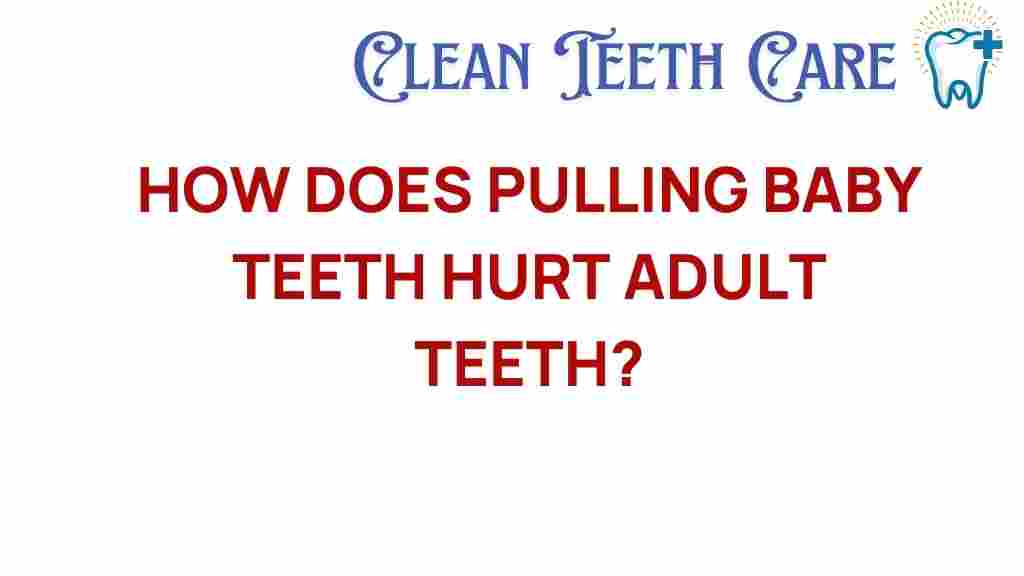The Surprising Link: How Baby Teeth Impact Adult Dental Health
When we think about dental health, we often focus on our adult teeth, assuming that baby teeth are just temporary placeholders that will disappear without any long-term effects. However, recent research has unveiled a surprising link between baby teeth and adult dental health. Understanding this connection can empower parents and caregivers to prioritize oral hygiene from an early age, ultimately leading to healthier smiles for life.
Understanding Baby Teeth and Their Importance
Baby teeth, also known as primary teeth, begin to emerge around six months of age and typically fall out by age twelve. These small, temporary teeth play a crucial role in a child’s development and oral health:
- Facilitating Eating: Baby teeth help children chew and enjoy a variety of foods, which is essential for proper nutrition.
- Aiding Speech Development: The presence of baby teeth supports speech development as children learn to articulate sounds.
- Guiding Adult Teeth: Baby teeth hold space in the jaw for adult teeth, ensuring they erupt in the correct position.
Neglecting baby teeth can lead to significant issues in adulthood, making it essential to prioritize pediatric dentistry.
The Connection Between Baby Teeth and Adult Dental Health
Research suggests that the health of baby teeth directly influences the condition of adult teeth. Here’s how:
- Cavities in Baby Teeth: If baby teeth develop cavities and are not treated promptly, the bacteria can spread to the adult teeth as they emerge.
- Misalignment Issues: Loss of baby teeth due to decay can lead to misalignment of adult teeth, which may require orthodontic treatment later.
- Oral Hygiene Habits: Poor dental hygiene during childhood can set the stage for lifelong habits, impacting overall dental health.
Thus, maintaining healthy baby teeth is critical for promoting good adult dental health.
Pediatric Dentistry: A Foundation for Healthy Smiles
Pediatric dentistry focuses on the unique dental needs of children, ensuring that their oral health is prioritized from a young age. Here are some key aspects:
- Regular Check-Ups: Children should visit the dentist regularly, starting by their first birthday or when their first tooth erupts.
- Preventive Care: Dentists can provide fluoride treatments and sealants to protect baby teeth from cavities.
- Education: Pediatric dentists educate parents and children about proper oral hygiene practices, including brushing techniques and diet.
By fostering a positive relationship with dental care early on, children are more likely to maintain good oral hygiene as they grow.
Common Dental Myths Surrounding Baby Teeth
There are several myths surrounding baby teeth that can lead to poor dental practices:
- Myth 1: Baby Teeth Don’t Matter: Many believe that since baby teeth will fall out, they don’t require much care. This is false; neglecting them can lead to problems for adult teeth.
- Myth 2: Cavities in Baby Teeth Are Not a Big Deal: Cavities can cause pain and infection, affecting the development of adult teeth.
- Myth 3: Brushing Baby Teeth Is Unnecessary: Starting good oral hygiene habits early is essential for preventing decay.
It’s crucial to debunk these myths to promote better dental health practices.
Step-by-Step Process for Maintaining Oral Hygiene in Children
Here’s a step-by-step guide to help parents ensure their children maintain optimal oral hygiene:
Step 1: Start Early
Begin cleaning your child’s gums with a soft, damp cloth even before teeth emerge. This helps establish a routine.
Step 2: Introduce Toothbrushes and Toothpaste
Once the first tooth appears, use a small, soft-bristled toothbrush with water or a smear of fluoride toothpaste suitable for children.
Step 3: Establish a Routine
Brush twice a day—once in the morning and once before bed. Make it a fun activity to encourage compliance.
Step 4: Schedule Regular Dental Visits
Visit the dentist every six months for check-ups. This helps catch any issues early and builds a positive attitude toward dental care.
Step 5: Monitor Diet
Limit sugary snacks and drinks, as they contribute to tooth decay. Encourage healthy snacks like fruits and vegetables.
Troubleshooting Common Issues
Even with the best efforts, children may still experience dental issues. Here are some common problems and solutions:
Problem 1: Tooth Pain
If your child is experiencing tooth pain, it may be indicative of a cavity or infection. Schedule an appointment with a pediatric dentist promptly.
Problem 2: Fear of the Dentist
If your child is anxious about dental visits, try to prepare them beforehand by reading books about going to the dentist or playing dentist at home.
Problem 3: Difficulty Brushing
Some children resist brushing. Consider using fun toothbrushes or toothpaste flavors to make the process more enjoyable.
The Pain Connection: Early Signs of Dental Issues
It’s essential to recognize the connection between pain in baby teeth and potential problems for adult teeth. If your child complains of tooth pain, it could be a sign of:
- Cavities: Look for dark spots on teeth or sensitivity to hot and cold.
- Infection: Swelling around the gums or persistent pain may indicate an infection requiring treatment.
- Impacted Teeth: If adult teeth are coming in but causing discomfort, consult your dentist for advice.
Addressing these issues promptly can prevent further complications.
Conclusion: Invest in Your Child’s Dental Future
In conclusion, the link between baby teeth and adult dental health is undeniable. By prioritizing oral hygiene from a young age, you can set the foundation for a lifetime of healthy smiles. Make regular dental visits a priority, debunk common dental myths, and instill good oral hygiene habits in your children. Remember, healthy baby teeth lead to healthy adult teeth, and investing time and effort in pediatric dentistry now will pay off in the long run.
For more information on pediatric dentistry, visit this helpful resource.
Stay informed about dental health and strategies to maintain it at every stage of life by checking out this external link.
This article is in the category Conditions and created by CleanTeethCare Team
